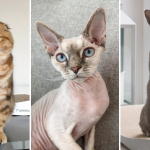Cats are incredibly clean creatures, who have mastered the art of self care. There’s no difference if it’s their paws that collected dust from under the cabinet, their whiskers to which the food stuck to or their bums after leaving the litter box – your cat knows very well how to get clean. As a responsible pawrent you must remember, though, that even for the cleanest cat, it’s not always enough: they might need their claws trimmed, ears cleaned, teeth checked or, if there’s a poo-mergency, a little help with cleaning it up 🙂 And their fur? Is it only long-haired cats who need special care, multiple brushes and the patience of a saint? Today we’re going into the topic of what with, when and how to brush your furries, so that everyone gets out of it safely. Are you curious?
Do all cats need brushing?
One of the biggest myths within the cat community is the assumption that long-haired cats need much more care and grooming than short-hairs. It is obviously true, that with a long fur we will have much more brushing to do and we’ll have to watch out for possible knots and matts. We can’t say, however, that a short-haired cat will be completely self-sufficient with his grooming and a brush or a comb will never get used.
Cat’s do put a lot of time into grooming themselves, fur included. Since they’re constantly licking it, their rough tongues collect some of the dead hairs that go straight into their tummies. In the shedding season (and all-year round), without any help from the pawrents, cats can get hairballs stuck in their digestive tract. If you do remember to regularly brush out your kitty, you will limit the risk of hairballs and also help yourself in the process – more brushing means less loose hair flying around the house! Does every cat need brushing then? Yes (unless it’s a hairless breed), but the amount and quality of grooming they’ll need is dependent on the length of their fur.
Short-haired and long-haired breeds: when does cat’s fur need grooming?
As far as brushing goes, short-haired cats need far less work on the pawrents side. You can’t, however, completely give up on grooming – brushing does not only remove dead hair and dirt from your kitty’s fur, it also has benefits for the blood circulation under their skin and the condition of their fur coat. Short-haired cats who are brushed regularly have a more shiny, soft and well-kept fur.
Long-haired cats will need brushing more often, than short-hairs. Depending on the individual and how easy to maintain their fur is, brushing might be needed 2-3 times a week or even daily. With the fluffiest and softest of cats, we’re not only taking care of removing dead hair and avoiding hairballs, we’re also avoiding the risk of knots and matts forming in their fur, often showing very close to the skin.
Tight and knotted matts pull on cat hair close to their skin, causing pain and irritation. Brushing them out is not the easiest. We have heard of horror stories of cats whose fur looked really nice and neat on the outside, but once they were brought to the groomers, they needed to be completely shaved. As it turned out, the hair on top that was smoothed over with a brush covered a lot of the matts close to the skin and the carers were completely unaware. If anyone tried to brush out matts like that, it would be torture for the poor kitty! By brushing regularly (with a comb that reaches to the skin), you can avoid many problems.

Brushing for a long-haired cat – what you need to know?
The biggest risk of matts and knots for long-haired cats is around their ruff, belly and pantaloons. When brushing, try to take special care of those areas and brush some of the more dense parts of your kitty’s fur before it becomes matted right by the skin. With a special powder or a detangling conditioner, it is usually possible to brush out the knots quite easily, without needing to cut them out. If the matts are, however, close to the skin or a particularly sensitive place (like their pantaloons), a careful trim and shaving off the matt is a better choice than pulling on the poor kitty’s fur and getting them scared of grooming all together.
Remember: the more often you brush your long-haired cat, the shorter the individual brushing sessions can be and the smaller chance of your kitty getting negative connotations with the sight of a brush or a comb. For cats that do like grooming, everyday brushing combined with petting might be a great choice.
Top accessories for grooming your cats
Good selection of high quality accessories is a must if we are to talk about proper grooming for cats. There’s so much to choose from today: combs, brushes and furminators will serve different purposes and different types of fur. We definitely recommend looking for them at professional groomer shops, as the cheapest plastic brushes usually do nothing more than build up static electricity. Shops for groomers will have a wider choice of comb lengths and widths, more brush shapes and different material options. It will be easier for you to find the accessories that actually fit your kitty’s needs.
While choosing cat grooming accessories, you might find:
- Slicker (paddle) brushes – brushes with soft, wire bristles are among the most popular choices for cat hair grooming. Without pulling out much hair, they let you brush out your pet’s fur quite well and can be used for both short-haired and medium-haired cats. When choosing, check for the length of the bristles – they can differ depending on the length of the fur.
- Combs are irreplaceable for long-haired breeds as well as short-haired cats with a thicker undercoat. There are many choices available: combs with wider-set teeth, great for grooming long-haired cats and best for getting rid of knots and matts, or fine-tooth combs for heavy undercoat, all with different lengths of teeth depending on how long your cat’s fur might be. Fine-tooth combs are good for removing dead hair, which reduces the risk of hairballs and matted fur by a lot.
- Brushes (plastic, rubber or with natural bristles) give a wide variety of choices, each serving a different purpose. Soft, natural bristles are not good for combing out the fur, but they can smooth it out and be used to finish off a grooming session (especially for long-haired cats). Rubber brushes can be used to gently get through the top fur coat and remove dead hair. With short-haired cats, they might be enough as far as accessories for grooming go. We don’t recommend plastic ones, ever. They cause static electricity build-up in the fur and although they’re cheap, they don’t do anything for our furry friends.
- Furminators are a specific type of a comb with very fine, metal teeth, used mainly to comb out thick, excess undercoat. Furminators will comb out most of the loose hair, but if they’re used too often, they will destroy the slick and shiny look of the fur. Don’t use it more than once a week and for cat’s who don’t have too thick of an undercoat, don’t use it at all. If you’re choosing a furminator for a long-haired cat, check if it’s made specifically for long hair – the smaller ones will remove the top hair instead of the undercoat.
- Brushing gloves might be a tempting choice, especially with cats who love being pet and cuddled. Gloves usually have short, rubber or wire bristles that can be a substitute for a standard rubber or slicker brush. You should remember, though, that it works mostly on the surface – it’s not guaranteed you’ll be able to brush through the fur and with both short- and long-haired cats it can work mostly as an additional step of grooming. However, a brushing glove can be good for Rex breeds and cats who only have their top coat (no undercoat) – they require a more gentle approach to brushing.
- Trimmers and tools for matts are only an addition to your accessories, for emergency use only. De-matting tools are generally small combs with sharp (knife-like) curved edges that can help you safely cut through knotted hair. They’re built so that you can’t hurt your cat, you won’t be excessively pulling on their skin, but you will be able to remove smaller knots and matts without having to cut them out.
Be careful: if a matt is close to the skin, your cat is trying to escape from the pain that you’re causing by pulling on it and the fur seems impossible to comb through, it might be better to just get a small trimmer and shave the matt off right at the skin. With some practice, you won’t remove too much fur (with long-hair it might be almost invisible) and you will relieve your cat’s pain. Pet trimmers (used by veterinarians and groomers) are much safer than trying to cut the matts out with scissors. Cat’s skin is very delicate and every little cut might bleed a lot.

Baths, shaving and professional groomers only for emergencies
To finish off, we shift our focus to some treatments that should get into your cat’s SPA routine only for special occasions. First, let’s look into bathing which we don’t recommend. Cats are able to take care of their own hygiene and the bathing process washes off both their natural scent and a natural protective barrier on their skin. You can bathe your kitty only in emergencies: when they get dirty (e.g. in the litter box, only if you can’t get everything off with a damp cloth) or if, for medical reasons, the cat is not able to clean him- or herself.
Another emergency solution regarding cat fur care is taking your pet to the groomer’s. Although it is popular among dog owners, there’s still not that many people specialising in cat care. If you’re not able to take care of your kitty yourself, it is advised to visit a specialist, but remember not to do it too often – it stresses your cat out. If there are any knots and matts in the fur, the groomer will try to remove it and it may make your cat scared of any brushing tools even more. And don’t even think about shaving your cat! Some people think it’s a good idea for summer, when cats get “too hot”, but in reality it’s the fur that keeps them naturally cool. The only situation when you would consider shaving your cat is for medical reasons (before a procedure) or if the fur is so matted, knotted and neglected, it’s easier to start over than to harm your cat.
How does your grooming process look, our dear fabCats? Did you manage to make the cat-brush relationship great from the get-go, or are they still running away at the sight of you opening a drawer where you keep the accessories? We’re waiting for your comments and tips on how to get a cat used to brushing if they’re long over the kitten stage – maybe someone managed to achieve success?





We always just touched them with combs and brushes as kittens allowed them to smell the item and gradually they started to enjoy and choose to come get brushed as soon as they see the comb brush or furminator
That’s such a great way of getting cats used to being brushed! And the fact that they like it and come as soon as they see the brush or a comb? Brilliant. 10/10 cat grooming expert, Laura! 🙂